Driving south on I-25 in late October, I knew as little about Billy the Kid as most people. Born Henry McCarty, he reached his teens in Silver City, NM, where he got in some trouble. He rode into Lincoln, 200 miles east of Silver City, as William H. Bonney, and hooked up with a young British businessman named John Tunstall who was shot dead by business rivals, launching the Lincoln County War. Billy killed people, escaped from jail, then was shot dead in the night by Sheriff Pat Garrett in Fort Sumner, NM. Billy the Kid was dead at 21.
Although I’ve counted Las Vegas as my hometown, and Santa Fe too, I had no idea as I drove through them that Billy the Kid had spent time in the jails of both towns. I was headed to the bottom of New Mexico with my Colorado friend Peter Burg to deliver a pair of large framed photographs for public installations at UNM Hospital in Albuquerque and the Luna County Sheriff’s Department in Deming. When we finished, we’d spend three days looking for great new photographs—a hunting expedition—from dawn to dusk daily, driving around southern New Mexico.
I had no idea that I was about to catch the Billy the Kid bug.

After photographing the verdant farm fields around the Rio Grande Valley village of Hatch, where chile and cotton and corn were growing even as snow covered our yards back home, I used Google Maps to find Mesilla so we could enjoy dinner and drinks at the historic La Posta restaurant, which had recently been featured in New Mexico Magazine. In the restaurant, I found Billy the Kid. He’d been there. So had Kit Carson.
Walking off dinner around the adjacent plaza, I found Billy the Kid again. In the corner building across a narrow lane from La Posta, he’d been tried and convicted of killing Sheriff William Brady in Lincoln. Brady’s successor, Pat Garrett, took Billy the Kid from that building back to Lincoln to hang.
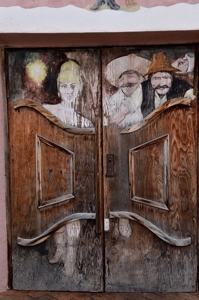
History is rich and unavoidable around the plaza at Old Mesilla, which was founded as La Mesilla when it was part of Mexico. No sooner did the United States annex New Mexico in 1853 than the new Butterfield Overland Stage Line made Mesilla an overnight stop on its route between St. Louis and San Francisco. Two Civil War battles were fought at Mesilla, where the Confederates established a capital until Union sympathizers routed it and established their own.
But in 1881—the year Pat Garrett shot Billy the Kid dead in Fort Sumner—the people of Mesilla declined the Santa Fe Railway’s request for a right of way. Instead, the railroad was built through neighboring Las Cruces, three miles east. As a result, Las Cruces today has the railroad and I-25 and more than 100,000 people while Mesilla is a quaint village of about 2000 people.
La Mesilla Historic District has been a National Historic Landmark since 1961. The plaza is often bustling as people visit retail shops and two more renowned restaurants, the Double Eagle and Josefina’s Old Gate. The impressive Basilica of San Albino has been an active Catholic church on the plaza since 1852.
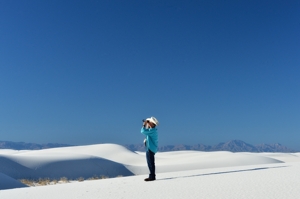
From Mesilla we crossed the sharply jagged Organ Mountains to reach a photographer’s paradise, White Sands National Monument northeast of Las Cruces in the Tularosa Basin, a kind of no-man’s land then and now. It’s the route from Mesilla to Lincoln. Pat Garrett and Billy the Kid rode through here together in 1881. Garrett later established his Black Mountain Ranch outside White Sands. In 1908, someone shot Garrett dead here alongside the road. Even today, no one’s sure who done it.
After photographing White Sands—a visually arresting place better conveyed through photography than writing—we spent our road trip’s fourth and final night in neighboring Alamogordo at the White Sands Motel, a lovely old motor court. Billy the Kid came back into my mind. I wondered whether there was a definitive book where I could learn his whole true story. Visiting Amazon on my laptop, I typed “Billy the Kid” and found 13,583 listings of available items—books, movies and more. That’s why I’ve never investigated Billy the Kid: Where would I even start?
But Amazon lists its merchandise in order of sales and its top-ranked item is “To Hell on a Fast Horse: The Untold Story of Billy the Kid and Pat Garrett,” an acclaimed 2010 book by Mark Lee Gardner of Cascade, CO, with 177 rave reviews from happy customers. Pay dirt. I ordered a copy that arrived at home shortly after I did. (Is Amazon today’s Pony Express?)

I learned that Pat Garrett and Billy the Kid were once neighbors in Fort Sumner; they would sometimes gamble in the same Fort Sumner cantina. They were both known to gamble in Tularosa, where I stopped to photograph the beautiful St. Francis de Paula Church just north of White Sands. North of Tularosa I photographed Three Rivers, once a trading post at the center of John Chisum’s and Susan McSween’s cattle empires—but then I took the turn toward home rather than the turn toward Lincoln where Chisum, McSween, Garrett and the Kid had all etched their names into history.
Gardner opens his book with Pat Garrett bringing the Kid into the jail at Las Vegas, which we’d passed through without knowing they’d ever been there. Garrett staved off a lynch mob at the new Las Vegas train depot (now alongside I-25) before continuing with his prisoner to Santa Fe. The kid was kept in a Santa Fe cell downtown on Water Street. Just four blocks long, Water Street is where, in a live-music coffeehouse 29 years ago this month, I met my wife, Christina Boyce. I never knew that Billy the Kid had spent some nights there.
Making extensive use of primary sources, Gardner’s impressive narrative succeeded at making me feel like I’d met the Kid and understood him. The Kid made friends easily, spoke Spanish well, had an active sense of humor, and loved to dance. Driven by a strong sense of loyalty and justice, he was also a cop killer. And he was an escape artist, escaping shoot-outs and jails multiple times, by any means necessary.
From Mesilla, Garrett took him back to Lincoln to hang. The kid shot his way free, killing two of Garrett’s deputies in the process. He didn’t flee New Mexico; he simply returned to his girlfriend and friends in Fort Sumner. This time Garrett wouldn’t try to catch Billy the Kid; he’d simply kill him.
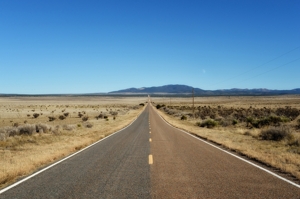
Finishing Gardner’s book, the hook had been set. Having just driven and photographed some of the places Garrett and the Kid had done their dance, it became easy for me to imagine them riding horseback across the land. They came to life. I grew hungry for another road trip. After three weeks at home, I took off again, just me and my camera this time, to chase Pat Garrett and Billy the Kid. I drove south to Lincoln.
Young Henry McCarty—the future Billy the Kid—moved out west with his mother and younger brother, from New York to Wichita to Denver to Santa Fe, where his mother finally married her boyfriend William Antrim in 1873. A year later she died of tuberculosis in Silver City and Antrim moved on. Henry Antrim, 15, was an orphan alone in Silver City.
Arrested for serving as a lookout for someone robbing a Chinese laundry, Henry escaped jail through a chimney—full-grown he reached only five feet three inches, 125 pounds—and ran away. In Arizona he learned how to support himself by stealing cattle and horses, and he learned how to play cards in bars. People called him “the kid.” One night a big bullying blacksmith named Windy Cahill, twice the kid’s age, beat Henry to the ground. Henry shot Cahill in the stomach. Cahill died in the morning, but Henry had already ridden east, back to New Mexico.

Riding a gray mare, he arrived in Lincoln with an alias—William H. Bonney, Jr.—although “the Kid” had stuck, too. Now eighteen years old, “Billy” was arrested for stealing two horses that belonged to John Tunstall, a wealthy 24-year-old Englishman who had recently arrived to build a cattle and mercantile empire in the American West. To the Kid’s surprise, Tunstall dismissed the charges and hired Billy to join his crew of young cowboys. Billy was later reported to have said of Tunstall, “He was the only man who ever treated me as if I was freeborn and white.”
Three months later John Tunstall was shot dead in Billy’s presence. The Kid went on the warpath.
***
I pulled into Lincoln at dusk in late November, having lingered longer than planned in the No Scum Allowed Saloon in White Oaks, a one-day horseback ride across the mountain from Lincoln. A mining boomtown during the Lincoln County War, today White Oaks is a sleepy enclave at the end of a remote road. It’s easy to imagine the past here, to see it, when Billy the Kid stole horses and Pat Garrett chased him back to Lincoln.
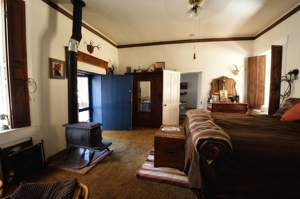
I intended to wander, taking photos and not planning meals or lodging in advance, so when I pulled in without a reservation at Ellis Store Country Inn, a B&B hosted by a former New Mexico Chef of the Year, I was lucky to get a room. Not just any room either. I got the Billy the Kid Room. The sign outside says, “Billy the Kid slept here.” Indeed, Ike Ellis’s store served as a refuge for the Kid and his friends right to the end, the night of “The Big Killing.”
Although they proved poor businessmen, Irish Catholic immigrants Lawrence Murphy and his protégé Jimmy Dolan had quickly built a far-reaching monopoly from Lincoln, controlling commerce and cattle. Among their successes, they supplied all the beef to the U.S. Army’s nearby Fort Stanton. English Protestant John Tunstall built a big store across Lincoln’s sole street from the Murphy-Dolan Store and proceeded to compete. Murphy and Dolan were livid, and they controlled the law.
When Sheriff William Brady’s men encountered Tunstall and his boys south of Lincoln, the young cowboys knew enough to scatter but Tunstall, filled with naïve confidence, rode right up to the Brady men. They shot him dead. Then they shot his horse.
Like the rest of Tunstall’s young cowboys, Billy had a strong sense of loyalty and justice. Now calling themselves “the Regulators,” they went to war against the Murphy-Dolan empire and its sheriff.

Six weeks after Tunstall’s death, Sheriff Brady got up from breakfast at Wortley’s Hotel, walked across the street to the Murphy-Dolan Store, then continued his morning walk down the street with his deputies. From behind Tunstall’s Store, Billy and the Regulators unleashed a barrage of rifle fire, killing the sheriff where he stood.
The Tunstall Store is still there, now a museum, as is the Murphy-Dolan Store. Wortley’s Hotel and Ellis Store are B&Bs. In fact, Lincoln Historic District has preserved almost everything as living history. Seven buildings serve as museums, all available for a single $5 ticket. The Anderson-Freeman Visitor Center & Museum serves as headquarters, the recommended starting place with its extensive displays and great foldout pamphlet that tells the whole story well.
Walking from Ellis Store on Lincoln’s east end, I toured all of the buildings within a half-day. (Two of the museums lack heat and are closed for the winter.) It’s only seven-tenths of a mile to the west end of Lincoln, where the Murphy-Dolan Store was converted into a new Lincoln County Courthouse in time to hold Billy the Kid—once they caught him.
Anarchy reined in Lincoln for more than three months, with countless killings on both sides of “the Lincoln County War.” Bodies lay in the street. Even the American president was alarmed, naming a new territorial governor, Lew Wallace, to clean up Lincoln.

The final showdown came in mid-July, 1878. Sometimes called “the Five-Day Battle,” culminating in “The Big Killing,” dozens on each side took up positions and fired on each other, creating a violent standoff. On July 19, Lt. Col. Nathan Dudley arrived from Fort Stanton with three-dozen troops, a 12-pound howitzer and a Gatling gun. He came to make the peace. He did it by pointing the artillery at Billy the Kid’s faction, holed up in three buildings.
Two of those buildings, Montano’s Store and Ellis Store, are still open. The third, the home of Tunstall’s attorney Alexander McSween, was burned down in the night amidst a hail of gunfire, killing McSween. Again proving his gift for escape, the Kid broke free and crossed the Rio Bonito into the hills. He was 19 years old.
Although charged with the murder of Sheriff Brady, the Kid moved somewhat freely for two more years, still making his living as a rustler, spending time in both Lincoln and Fort Sumner. He made a deal with Governor Wallace to testify against the Murphy-Dolan faction, after which his charges would be dropped. Wallace betrayed the Kid, never honoring his side of the agreement; in fact, Wallace later offered a $500 reward for Billy’s capture.

Pat Garrett, a new Lincoln County Sheriff accompanied by a posse, tracked Billy to Fort Sumner just before Christmas, 1880, killing fellow Regulators and capturing the Kid 12 miles east of town at Stinking Spring. When Garrett and the Kid arrived in Las Vegas to take the new railroad south through Santa Fe to Mesilla, the Las Vegas Gazette portrayed the Kid and his friends as dangerous criminals. For the first time, he was called “Billy the Kid.” It was a catchy title. Spurred by the new telegraph and Americans’ infatuation with the West, he became a celebrity not only in the East, but overseas as well, America’s first famous bad boy.
Seven months after acquiring the name, Billy the Kid was dead.
***
With Billy convicted in a Mesilla courtroom of Sheriff Brady’s murder, Garrett brought him back to Lincoln to await his hanging date. Ironically, the Kid was held upstairs in the old Murphy-Dolan Store, now converted to the new county courthouse.

While Garrett was away in White Oaks, one of Billy’s two guards, Deputy Bob Olinger, took a dinner break across the street at Wortley’s Hotel. Billy told Deputy James Bell that he needed a trip to the outhouse. When they came back inside, Billy had gotten a gun—no one’s sure how—and he shot Bell on the staircase. There’s still a prominent bullet hole at the bottom of the stairs. Bell died just outside as Billy raced up the stairs. Grabbing Olinger’s shotgun, he awaited Olinger from the upstairs window.
Olinger heard the gunshot and came running across the street. From the corner window above, Billy called out, “Hello Bob.” As Olinger looked up, Billy shot him with both barrels of his own shotgun. Olinger died right there.
Instead of bolting for Mexico, Billy simply rode back to Fort Sumner where he had a girlfriend and was well liked. That’s part of his appeal—and he grew much more famous now—he was a loyal friend with a lively sense of humor; he loved and respected the ladies and he loved to dance. Since arriving in New Mexico he’d become fluent in Spanish; the Hispanic community counted him as one of its own.
Garrett raced back to Lincoln. He later told a writer, “I knew now that I would have to kill the Kid. We both knew that it must be one or the other of us if we ever met.”
Soon, Garrett set off for Fort Sumner.
After a second night enjoying the peace and crackling woodstove in the Billy the Kid Room at Lincoln’s Ellis Store Country Inn, I, too, set off for Fort Sumner.
The drive from Lincoln to Fort Sumner affords plenty of time to imagine horsemen making the same journey 135 years ago. About 100 miles on horseback, 140 miles by today’s paved highways, both Billy the Kid and Pat Garrett made this commute countless times. They probably made the ride in two days, carrying food and water and bedrolls along with their firearms.
A trip to White Oaks would take just one day, Mesilla seven. Garrett and the Kid both made trips like this all the time, east into Texas, north as far as Puerto de Luna and Anton Chico near Las Vegas. Life on the trail took up much of their lives. They valued good horses. With the need for quick getaways, horse thieves like Billy always kept the best for themselves.
Hoping for the same great luck I’d had at the Ellis Store Country Inn in Lincoln, I drove straight to the Billy the Kid Country Inn, directly across Highway 60 from the 62-year-old Billy the Kid Museum in Fort Sumner. No luck. The Inn has been contracted to BNSF Railway for three years while its workers build two new bridges over the Pecos River at the western edge of town. They have two years to go.
Although the highway carries thousands of long-distance travelers through Fort Sumner each day, there are few dining and lodging choices available. I stayed at a Super 8 and saw no sign of Billy the Kid.
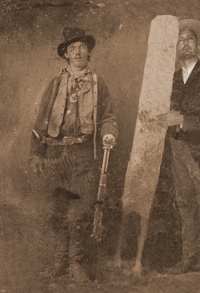
He called Fort Sumner home for much of his last four years. Pat Garrett lived there at the same time, even working as bartender at Beaver Smith’s saloon where Billy liked to gamble and dance. The two spent enough time together that some called them Little Casino and Big Casino. Their paths diverged when Garrett accepted the job of Lincoln County Sheriff.
Their Fort Sumner hugged the Pecos three miles southeast of today’s Fort Sumner, which migrated north to the railway when it came through. I drove down to the Fort Sumner Historic Site on a Monday morning, only to learn that it’s fenced in and closed on Mondays and Tuesdays. My luck seemed to have turned since Lincoln. With a sitemap I’d found in town, I could look from a side road and almost tell—all that remains of the buildings are markers—where Beaver Smith’s saloon was, where the old Indian hospital was where Garrett laid in ambush for the Regulators, killing Tom Folliard but missing the Kid. I could tell where Pete Maxwell’s house was, where, seven months after the botched hospital ambush, Garrett waited in a dark bedroom and killed Billy the Kid.
Barely escaping Garrett’s hospital ambush, Billy and four fellow Regulators went on the run. Garrett and his posse followed. Five days later and 12 miles east at a remote crossroads called Stinking Spring, Garrett followed the Regulators’ tracks in the snow to a rock-and-adobe structure, 12 by 30 feet with just one doorless opening. It was 3 a.m. He had them pinned.
In the frozen dawn, a man emerged with a feedbag for the horses outside. He wore a sombrero like Billy’s. Garrett and his men filled him with seven rifle shots. They’d killed Charlie Bowdre, not the Kid.
A standoff lasted all day. At one point the bandits tried to pull their horses through the doorway so they could bolt out and make a run for it. Garrett shot and dropped a horse right in the doorway, blocking it.
At the end of a long day that saw many bullets fly but no one else hit, the four desperados emerged with their hands in the air. Billy’s penchant for escape had failed him. Garrett escorted all four to Las Vegas, then onto a train south to trial in Mesilla.
***
 Although there’s no longer anything there, Stinking Spring is on Google Maps. From Old Fort Sumner I drove east past Taiban to Black Hat Road and turned south, crossing coarse new gravel on the railroad right-of-way, then a mile south to a family ranch house. With only a mile left to Stinking Spring, the road now turned rough, no problem for my pickup at home but too rough, I judged, for the dainty Toyota Prius I was driving on this road trip. My Fort Sumner luck continued. At least I wasn’t taken back up Black Hat Road in handcuffs.
Although there’s no longer anything there, Stinking Spring is on Google Maps. From Old Fort Sumner I drove east past Taiban to Black Hat Road and turned south, crossing coarse new gravel on the railroad right-of-way, then a mile south to a family ranch house. With only a mile left to Stinking Spring, the road now turned rough, no problem for my pickup at home but too rough, I judged, for the dainty Toyota Prius I was driving on this road trip. My Fort Sumner luck continued. At least I wasn’t taken back up Black Hat Road in handcuffs.
It got better, though. The Billy the Kid Museum pulled together everything I’d learned and more. Operated by one family since 1953, they’ve amassed more than 60,000 items showing the area’s rich history. Billy the Kid’s chaps, spurs and rifle are there, along with a rock on which he carved his name, and the curtain he passed through just as Pat Garrett shot him to death in Pete Maxwell’s house.
The clerk suggested that I start in the mini-theater to watch the 50-minute PBS American Experience documentary “Billy the Kid.” It was so good that I ordered my own copy, joining Lincoln Historic Site’s large foldout pamphlet and Coloradan Mark Lee Gardner’s “To Hell on a Fast Horse: The Untold Story of Billy the Kid and Pat Garrett” as the perfect introductions to this uniquely American story.

A National Geographic documentary premiered in late October with DVD release January 16, 2016. Narrated by Kevin Costner, “Billy the Kid: New Evidence” examines a new photo of Billy the Kid bought at a California memorabilia show in 2010 for $2 and now appraised and insured at $5 million.
The films reminded me of “Young Guns,” the popular 1988 Hollywood movie version of Billy the Kid and the Regulators, a good portrayal. I remember our living room outside Las Vegas filled with long clothing racks when my wife, Christina Boyce, made five each of Billy’s and the Regulators’ costumes for “Young Guns.” The movie’s Lincoln scenes were all filmed in Cerrillos, near Christina’s family home on the Turquoise Trail south of Santa Fe. No longer a costumer, Christina is now the director of Trinidad’s A.R. Mitchell Museum of Western Art and brings me True West magazines with Billy the Kid on the cover.
***
 On the way out of Fort Sumner, I stopped at the De Baca County Courthouse and walked upstairs to see Russell Vernon Hunter’s three large 1936 WPA murals depicting the area’s history. There in one panel was Billy the Kid, his mom, his gray mare, his friends Charlie Bowdre and Tom Folliard, his one-time friend Pat Garrett, and Pete Maxwell and his house where Garrett killed the Kid.
On the way out of Fort Sumner, I stopped at the De Baca County Courthouse and walked upstairs to see Russell Vernon Hunter’s three large 1936 WPA murals depicting the area’s history. There in one panel was Billy the Kid, his mom, his gray mare, his friends Charlie Bowdre and Tom Folliard, his one-time friend Pat Garrett, and Pete Maxwell and his house where Garrett killed the Kid.
I followed the Pecos north to Puerto de Luna where Billy liked to spend time. The quaint farming village was later the home of Rudolfo Anaya’s mother’s family and plays a big part in one of my favorite novels, Anaya’s classic New Mexico coming-of-age tale, “Bless Me, Ultima.” In nearby Santa Rosa I got my first look at the city’s 2007 homage to its native son, a sculpture garden showing Anaya writing, surrounded by pages from his most famous book. Across the park, I got my first look at Santa Rosa’s famed Blue Hole, where scuba divers make pilgrimages to explore the pool’s 81-feet-deep crystal-clear spring-fed waters.

Driving home past Anton Chico and Las Vegas, I’d spent five days chasing Billy the Kid and Pat Garrett. My route—through Las Vegas, Santa Fe, Mesilla, White Sands, Tularosa, Lincoln, Fort Stanton, Fort Sumner, Puerto de Luna and Santa Rosa—would make an 1100-mile loop from Trinidad. Swinging west to include Silver City would add 120 scenic miles to the trip.
In fact it’s all scenic, much of it dramatically so. I hadn’t realized that there is no place in New Mexico without mountains. The expanses can appear endless, the distances daunting, reminding me that this is why I moved to New Mexico in the first place: wide open spaces, dramatic landscapes, and a rich tri-cultural history that includes a scrawny kid who laughed easily and loved to dance. He was also a thief, rustler and killer gunned down at the age of 21.
With the exception of a few cities and the long asphalt roadways, my route was remarkably little changed from 135 years ago when Pat Garrett and Billy the Kid traveled these paths incessantly, riding horses day after day, camping night after night, just to get to the next town. I enjoyed the long drives when I’d try to imagine—to see—Garrett or the Kid riding alongside out there. Time after time, I succeeded.
***
MAP
Chasing Billy the Kid was first published, with photo captions and additional photos, by The Chronicle-News on three consecutive Fridays in January 2016 -- available here.
The two Billy the Kid paintings are by Peter Rogers, 1984, photographed at Lincoln's Anderson-Freeman Visitor Center and Museum.
Click any photograph to see it enlarged.